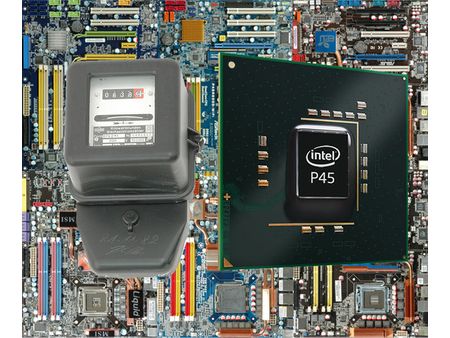Power-Saving Motherboards: Fact Or Fiction?
The P45 Efficiency Battle
The days of significant performance differences between motherboards are over. Really?
Motherboard makers have come a long way. First they’ve differentiated their products by adding storage, interface controllers and other complementary components. Then, they’ve upgraded their overclocking capabilities, making many high-end motherboards great for hardcore enthusiasts. Massive cooling structures made of copper and creative shapes followed, all in an effort to assist cooling capacity.
Now, though, as manufacturers embrace the need to go green—improving energy efficiency for the sake of the environment—we’ve discovered noticeable differences in the way power-saving techniques are implemented, and how they affect performance.
Green IT To The Rescue?
This has been the year of green computing and the IT industry has been using the color green, typically associated with nature and ecology, to designate environmentally-friendly products and strategies. But manufacturers don’t go green just because they care about the environment. They do it because it’s required by law in key markets, and because users increasingly demand it. But make no mistake about it: going green is a business decision.
The European Union’s RoHS guideline, restricting “the use of certain hazardous substances in electrical and electronic equipment” went into effect in 2006; it prohibits the use, specifically, of lead, mercury, cadmium, and various other substances in printed circuit boards. Virtually all motherboards are now RoHS-compliant. Production, however, is still resource-intensive, which is why no manufacturer likes to disclose the amount of water and power necessary to produce a motherboard. Clearly, the products are more environmentally friendly, but manufacturing isn’t. Still, no RoHS, no business.
The next step toward making computers environmentally friendly is to reduce their power consumption by minimizing the amount of energy that components—graphics solutions, processors, and, yes, even motherboards—waste when they run idle. Any component that requires power has the potential to save power.
Get Tom's Hardware's best news and in-depth reviews, straight to your inbox.
Motherboard Power-Saving Techniques
The best way to reduce motherboard power consumption is to limit the number of electrical components. Every FireWire controller, every sophisticated voltage regulator, every memory module increases system power consumption in two ways: it takes energy to operate these components and their use contributes to the total absolute power loss of your power supply.
Motherboard makers offset some of their products’ power consumption by dynamically switching voltage regulators on and off: relying on all six to 12 voltage regulators for processing provides more reliable power under high currents, while using only one or two voltage regulators reduces power requirements during idle periods. These technologies are a big part of marketing nowadays and we want to figure out if they actually work. We test six motherboards from ASRock, Asus, Foxconn, Gigabyte, and MSI to see which is most efficient.
